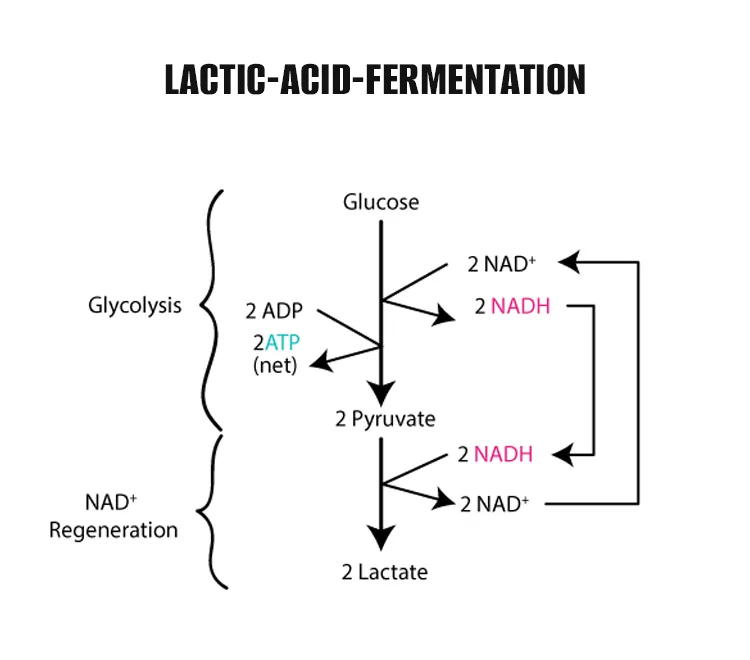
Types of Fermentation: Understanding fermentation is essential for NEET students, as it forms a critical part of the biology syllabus, particularly in units dealing with cellular processes. This article simplifies the concept of fermentation, outlining its types, processes, and advantages to help you grasp the subject thoroughly.
Fermentation is a metabolic process that converts sugar to acids, gases, or alcohol. It occurs in yeast, bacteria, and oxygen-starved muscle cells, as in the case of lactic acid fermentation. This process is anaerobic, which means it takes place without oxygen.Fermentation Definition
Scientifically, fermentation is defined as the chemical breakdown of a substance by bacteria, yeasts, or other microorganisms. In the context of biology and chemistry, it particularly refers to the process in which cells release energy from nutrients without needing oxygen.NEET Previous Year Question Papers
Types of Fermentation
There are several types of fermentation that you need to know about, each with unique characteristics and biological significance:1. Alcoholic Fermentation
Alcoholic fermentation, also known as ethanol fermentation, is a biological process that converts sugars such as glucose, fructose, and sucrose into cellular energy, producing ethanol and carbon dioxide as by-products. This process is carried out by yeasts and some types of bacteria. The chemical equation for alcoholic fermentation can be represented as:


2. Lactic Acid Fermentation
Lactic acid fermentation occurs when pyruvate (from glucose breakdown) is reduced to lactic acid by the enzyme lactate dehydrogenase. This process occurs in certain bacteria and animal muscle cells under anaerobic conditions, such as during strenuous exercise. The chemical reaction can be expressed as:


3. Acetic Acid Fermentation
Acetic acid fermentation is a two-step process where ethanol is first produced through alcoholic fermentation and then converted into acetic acid by acetic acid bacteria (AAB). The chemical conversion involves the oxidation of ethanol into acetic acid, and the overall reaction is:
![]()
4. Butyric Acid Fermentation
Butyric acid fermentation involves the fermentation of carbohydrates like starch and sugars by butyric acid bacteria, producing butyric acid, carbon dioxide, hydrogen, and other by-products. This fermentation is less common in the food industry but is important in the biochemical industry and the gastrointestinal tracts of ruminants. The pathway is more complex, involving several steps to break down glucose into butyric acid.5. Mixed Acid Fermentation
Mixed acid fermentation is used by various bacteria including Escherichia coli and other Enterobacteriaceae. These bacteria convert pyruvate, derived from glucose, into a mix of acids (lactic, acetic, succinic, and formic acids) along with ethanol, hydrogen, and carbon dioxide. This type of fermentation is significant in microbial ecology and industrial microbiology because of the range of chemicals produced, which can influence the environment of the gastrointestinal tract and other anaerobic ecosystems. Each type of fermentation has distinct biochemical pathways and is used differently in biological and industrial applications, highlighting the versatility and importance of understanding these processes for NEET aspirants.Sexual Reproduction in Flowering Plants
Fermentation Process
The fermentation process typically involves the following steps:- Anaerobic Conditions: Fermentation occurs without the presence of oxygen. Cells switch to fermentation to generate usable energy under anaerobic conditions.
- Glucose Breakdown: The process begins with the breakdown of glucose. This sugar is converted into simpler molecules, releasing energy that is stored in ATP (adenosine triphosphate) molecules.
- Product Formation: Depending on the type of fermentation, various end products are formed such as ethanol, lactic acid, or hydrogen gas.
Fermentation Examples
Find below the examples of Fermentation:Alcoholic Fermentation Examples
- Beer Brewing: Yeasts, primarily Saccharomyces cerevisiae , ferment malted barley to produce beer. The sugars in the malted barley are converted into alcohol and carbon dioxide.
- Wine Production: In winemaking, yeasts ferment the natural sugars found in grapes. The process varies slightly depending on the type of wine being produced but fundamentally relies on alcoholic fermentation.
- Ethanol Fuel: Ethanol for fuel is produced using alcoholic fermentation on a large scale, often using biomass such as corn, sugarcane, or cellulose.
2. Lactic Acid Fermentation Examples
- Yogurt: Lactic acid bacteria ferment lactose, the sugar in milk, into lactic acid which acts on milk protein to give yogurt its texture and tangy taste.
- Sauerkraut: The fermentation of cabbage by lactic acid bacteria, mainly Leuconostoc , Lactobacillus , and Pediococcus , results in sauerkraut, a dish noted for its distinct sour flavor.
- Kefir: A fermented milk drink similar to a thin yogurt, kefir is made by fermenting milk with kefir grains, which contain a complex mixture of lactic acid bacteria and yeasts.
3. Acetic Acid Fermentation Examples
- Vinegar Production: Vinegar is produced by acetic acid fermentation through the action of acetic acid bacteria on ethanol, which is often derived from wine, cider, or fermented fruit juices.
- Kombucha: Kombucha is a fermented tea that involves a symbiotic colony of bacteria and yeast (SCOBY). In its secondary fermentation stage, acetic acid fermentation gives kombucha its characteristic sour taste.
4. Butyric Acid Fermentation Examples
- Butter and Cheese Flavoring: The characteristic flavors of certain butter and cheeses are partly due to butyric acid produced during fermentation.
- Bioplastics Production: Butyric acid produced from agricultural wastes through fermentation is used as a precursor for the production of biodegradable plastics.
5. Mixed Acid Fermentation Examples
- Industrial Solvents: Mixed acid fermentation by bacteria like Escherichia coli can produce solvents such as ethanol and acetone, which are used in various industrial applications.
- Pharmaceuticals: Some by-products of mixed acid fermentation are used in the manufacture of pharmaceuticals and as intermediates in chemical synthesis.
Advantages of Fermentation
Fermentation offers several biological and industrial advantages:- Energy Production: It provides cells with a means of energy production in the absence of oxygen.
- Food Preservation: Fermentation helps in preserving food and enhancing its nutritional value.
- Industrial Applications: It is crucial in the production of alcohol, bread, yogurt, and many other products.
- Environmental Benefits: Fermentation is used in waste management and bioremediation by breaking down organic materials.

Types of Fermentation FAQs
Q 1: Why is fermentation important in cellular biology?
Ans: Fermentation allows cells to produce energy without oxygen, which is vital during anaerobic conditions.
Q 2: Can fermentation occur in human cells?
Ans: Yes, human muscle cells can perform lactic acid fermentation when oxygen levels are low, such as during intense exercise.
Q 3: How is alcoholic fermentation different from lactic acid fermentation?
Ans: Alcoholic fermentation produces ethanol and CO2, whereas lactic acid fermentation results in lactic acid as the primary product.
Q 4: What products are made using acetic acid fermentation?
Ans: Acetic acid fermentation is used primarily in the production of vinegar.
Q 5: How does fermentation impact the food industry?
Ans: Fermentation is crucial for producing a wide variety of food products, including bread, cheese, yogurt, and alcoholic beverages, enhancing their flavor, texture, and preservability.
🔥 Trending Blogs
Talk to a counsellorHave doubts? Our support team will be happy to assist you!

Free Learning Resources
PW Books
Notes (Class 10-12)
PW Study Materials
Notes (Class 6-9)
Ncert Solutions
Govt Exams
Class 6th to 12th Online Courses
Govt Job Exams Courses
UPSC Coaching
Defence Exam Coaching
Gate Exam Coaching
Other Exams
Know about Physics Wallah
Physics Wallah is an Indian edtech platform that provides accessible & comprehensive learning experiences to students from Class 6th to postgraduate level. We also provide extensive NCERT solutions, sample paper, NEET, JEE Mains, BITSAT previous year papers & more such resources to students. Physics Wallah also caters to over 3.5 million registered students and over 78 lakh+ Youtube subscribers with 4.8 rating on its app.
We Stand Out because
We provide students with intensive courses with India’s qualified & experienced faculties & mentors. PW strives to make the learning experience comprehensive and accessible for students of all sections of society. We believe in empowering every single student who couldn't dream of a good career in engineering and medical field earlier.
Our Key Focus Areas
Physics Wallah's main focus is to make the learning experience as economical as possible for all students. With our affordable courses like Lakshya, Udaan and Arjuna and many others, we have been able to provide a platform for lakhs of aspirants. From providing Chemistry, Maths, Physics formula to giving e-books of eminent authors like RD Sharma, RS Aggarwal and Lakhmir Singh, PW focuses on every single student's need for preparation.
What Makes Us Different
Physics Wallah strives to develop a comprehensive pedagogical structure for students, where they get a state-of-the-art learning experience with study material and resources. Apart from catering students preparing for JEE Mains and NEET, PW also provides study material for each state board like Uttar Pradesh, Bihar, and others
Copyright © 2025 Physicswallah Limited All rights reserved.
Get App









